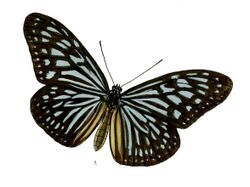Biology:Ideopsis vulgaris
| Blue glassy tiger | |
|---|---|

| |
| Illustration of Ideopsis vulgaris | |
| Scientific classification | |
| Domain: | Eukaryota |
| Kingdom: | Animalia |
| Phylum: | Arthropoda |
| Class: | Insecta |
| Order: | Lepidoptera |
| Family: | Nymphalidae |
| Genus: | Ideopsis |
| Species: | I. vulgaris
|
| Binomial name | |
| Ideopsis vulgaris (Butler, 1874)
| |
| Synonyms[1] | |
|
List
| |
Ideopsis vulgaris, the blue glassy tiger, is a butterfly that belongs to the crows and tigers, that is, the danaid group of the brush-footed butterflies family.
Subspecies
Subspecies include:[2][3]
- Ideopsis vulgaris contigua Talbot, 1939 – (Central Thailand, Laos, Vietnam, Hainan, China )
- Ideopsis vulgaris macrina (Fruhstorfer, 1904) – Myanmar, P. Thailand, Langkawi, W. Malaysia, Singapore, Sumatra, Batu Islands, Banka Island, Belitung)
Distribution
This species can be found in India , Singapore, Thailand, Laos, Vietnam, Hainan, South Burma - Sundaland, Sumatra, Java, Lesser Sunda Islands - Alor, Borneo – Palawan.[2]
Habitat
These butterflies inhabits a range of habitats, but especially occur at the edge of rainforest or plantations and in the coastal mangrove areas.[4]
Description
Ideopsis vulgaris has a wingspan reaching 70–80 millimetres (2.8–3.1 in).[5][6] This butterfly is quite similar to the dark glassy tiger (Parantica agleoides). A transverse black bar in the forewing cell, cutting through one of the white streaks, distinguishes the blue glassy tiger from the other one.[5] As other milkweed butterfly it is mimicked by Chilasa clytia (Papilionidae).
Upperside: black, the dorsal margin of hindwing broadly cinereous; both wings with the following subhyaline bluish-white streaks and spots.
Forewing: a short streak along dorsal margin, two broad streaks united at base in interspace 1, the upper one curved, a broad streak in cell with an outwardly indented detached spot beyond it in apex, a slender costal streak, two large discal spots inwardly pointed, outwardly truncate, three elongate spots beyond apex of cell and four or five elongate preapical spots beyond them, finally a subterminal and a terminal series of spots decreasing in size towards apex of wing.
Hindwing: elongate streaks in interspaces 1 a and 1 b, two in interspace 1, two in cell with a short slender streak-obliquely between their apices, shorter streaks radiating outwards in interspaces 2–6, a sub-terminal series of small spots and a terminal row of dots beyond.
Underside: similar, the markings better defined. Antennae black, palpi black above, bluish white below; head and thorax black, spotted with bluish white; abdomen brown above, sullied white below. Male without any special sex-marks on the wings.[7]
Race exprompta, Butler (Sri Lanka). Closely resembles D. vulgaris Butler, but has all the markings much broader, the apical spot in cell of forewing outwardly less emarginate; on the hindwing interspaces 1 a and 1 b are entirely filled with the white streak, while the short slender streak lying between the apices of the streaks in the cell coalesces with the lower one.
Race nicobarica, W.-M. & de N. (Nicobar Islands). Like the preceding race, but the subhyaline markings still broader and somewhat blurred. Upperside: forewing: the whole basal two-thirds of interspace 1 bluish white, enclosing a fine longitudinal black line; streak in discoidal cell vary broad, occasionally produced to the apical spot in the cell. Hindwing: the black in interspace 1 reduced to a mere streak; cell entirely bluish white, traversed longitudinally by a faint black forked line. In the solitary specimen of the male in the collection of the British Museum this line is entirelyabsent.
Similar species
- Blue tiger (Tirumala limniace)
- Dark glassy tiger (Parantica agleoides) [5]
Biology
File:Ideopsis vulgaris macrina - The Blue Glassy Tiger.webm Adults can be found all the year around.[8] They frequently visit flowers for feeding.
Females lay white eggs similar to a rugby ball. These eggs take about 3 days to hatch. The caterpillars are white with a black head, while the 2nd instar caterpillars are dark wine red to dark purplish brown colored, with whitish spots and a length about 7.5–8 mm (0.30–0.31 in). In the 5th and last instar caterpillars reach 34 mm (1.3 in).[5]
Larvae feed on Gymnema species (Asclepiadaceae),[5] Tylophora fleuxosa (a climber typical of mangrove areas),[5] Tylophora tenuissima (Apocynaceae) and is thus distasteful to birds.[2]
The pupa is bright yellowish green, with a length of 18–20 mm (0.71–0.79 in). After about 7 days the butterfly emerges.[5]
See also
References
- ↑ Nymphalidae.net
- ↑ 2.0 2.1 2.2 Ideopsis vulgaris, Funet.fi
- ↑ Yutaka Inayoshi Butterflies in Indo-China
- ↑ Muller, C.J. & Tennent, W.J. 2011 The IUCN Red List of Threatened Species 2011
- ↑ 5.0 5.1 5.2 5.3 5.4 5.5 5.6 Butterfly Circle
- ↑ Peter K. L. Ng, Richard Corlett, Hugh T. W. Tan Singapore Biodiversity: An Encyclopedia of the Natural Environment
- ↑ Bingham, C.T. (1905). The Fauna of British India, Including Ceylon and Burma Butterflies. 1 (1st ed.). London: Taylor and Francis, Ltd..
- ↑ iNaturalist
External links
| Wikimedia Commons has media related to Ideopsis vulgaris. |
- Brower, Andrew V.Z. (2010). Glassy Tigers
Wikidata ☰ Q2675426 entry
 |



